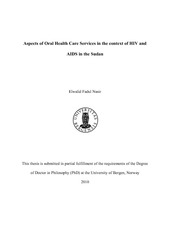| dc.contributor.author | Nasir, Elwalid Fadul | en_US |
| dc.date.accessioned | 2016-12-01T12:37:19Z | |
| dc.date.available | 2016-12-01T12:37:19Z | |
| dc.date.issued | 2010-10-01 | |
| dc.identifier.isbn | 978-82-308-1597-7 | en_US |
| dc.identifier.uri | https://hdl.handle.net/1956/15222 | |
| dc.description.abstract | Introduction: Sub-Saharan Africa is a home to 67% of all people living with HIV-infection. War and the resulting population movements, Sudan's long borders with countries which have high HIV-prevalence, all these conditions beside others interacted to provide an enabling environment for rapid spread of HIV infection. As the increase of the epidemic, the demand for care rises for those living with HIV and AIDS, with no exception among health workers. Objectives: the overall aim of this thesis was to assess HIV and AIDS-related aspects in dental services in the Sudan. The thesis had the following specific objectives; to evaluate the HIV and AIDS-related knowledge of dental students, sources of information, and their perceived need for further education. To predict the intention of senior dental students in Sudan together with dental and medical students in Tanzania to provide surgical treatment to patients infected with HIV applying the theory of planned behavior (TPB). To asses the dental patients’ utilization of dental services in the context of HIV and AIDS in Sudan using Andersen's Behavioral model of Health services utilization. Methodology: A census of senior dental students (3rd to 5th study year) in six dental faculties in Sudan beside dental and medical students in Tanzania participated in a self-administered questionnaire. A census of all dental patients attended two dental teaching hospitals (out-patient) in Khartoum during the period of the study. A designed interview was used, followed by a clinical examination. Results: Students from private dental schools were more knowledgeable about various HIV related issues than their counterparts from public dental schools. Publicly funded dental school students were less likely to have correct knowledge about modes of HIV transmission (OR = 0.6) and occupational risk groups (OR = 0.6) and to have received information from lectures/health care workers (OR = 0.5). Tanzanian and Sudanese students showed a strong intention to provide care for patients with HIV and AIDS. Theory of Planned Behavior accounted for 51% (43% in Tanzania and Sudan) of the variance in intention across study sites. Across both study sites, attitudes were the strongest predictor of intention followed in descending order by subjective norms, moral norms and perceived behavioral control. With a response rate of 52% of dental patients, among predisposing factors; travelling inside Sudan (OR= 0.5) were associated with lower odds and females were associated with higher odds (OR= 2.0) for dental service utilization. While among enabling factors; higher knowledge of HIV transmission (OR = 0.6) and higher HIV related experience (OR = 0.7) were associated with lower odds, whereas positive attitudes towards infected people and high perceived risk of contagion (OR = 1.3) were associated with higher odds for dental care utilization. Among need related factors dental caries experience was strongly associated with dental care utilization (OR= 4.8). Conclusion: Students attending private dental schools were more knowledgeable about various HIV related issues than students from public dental schools. About half of all students reported need for further education. This suggests that students are not adequately prepared for treating patients with HIV infection and AIDS and that the dental school curriculum needs improvements. The TPB is applicable to students' care delivery intentions in the context of HIV and AIDS across the two countries investigated. It is suggested that attitudes, subjective norms, moral norms and perceived behavioral control are key factors in students' willingness to treat AIDS and HIV infected patients and should be targets of interventions aimed at improving the quality of health care delivery in this context. Disparity in the dental care utilization goes beyond socio-demographic position and need for dental care. Public awareness of HIV infection control and confidence on the competence of dentists should be improved to minimize avoidance behavior and help establish dental health care patterns in Sudan. | en_US |
| dc.language.iso | eng | eng |
| dc.publisher | The University of Bergen | eng |
| dc.relation.haspart | Paper I: Nasir EF, Astrøm AN, David J, Ali RW. HIV and AIDS related knowledge, sources of information, and reported need for further education among dental students in Sudan--a cross sectional study. BMC Public Health. 2008 Aug 14;8:286. The article is available at: <a href="http://hdl.handle.net/1956/8721" target="blank">http://hdl.handle.net/1956/8721</a> | en_US |
| dc.relation.haspart | Paper II: Astrøm AN, Nasir EF. Predicting intention to treat HIV-infected patients among Tanzanian and Sudanese medical and dental students using the theory of planned behaviour--a cross sectional study. BMC Health Serv Res. 2009 Nov 20;9:213. The article is available at: <a href="http://hdl.handle.net/1956/9294" target="blank">http://hdl.handle.net/1956/9294</a> | en_US |
| dc.relation.haspart | Paper III: Nasir EF, Astrøm AN, David J, Ali RW. Utilization of dental health care services in context of the HIV epidemic- a cross-sectional study of dental patients in the Sudan. BMC Oral Health. 2009 Nov 16;9:30. The article is available at: <a href="http://hdl.handle.net/1956/9287" target="blank">http://hdl.handle.net/1956/9287</a> | en_US |
| dc.title | Aspects of Oral Health Care Services in the context of HIV and AIDS in the Sudan | en_US |
| dc.type | Doctoral thesis | |
| dc.rights.holder | Copyright the Author. All rights reserved | |
| dc.identifier.cristin | 295302 | |
